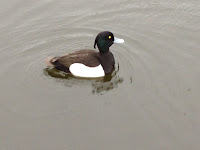First off, I don't have any pets other than small tropical fish, so I went to the park.
The ducks looked good to me, particularly the texture of the female mallard feathers, and the sinuous shapes of the necks.
 There are the feathers I mean, and the contrast between the strong textural feel of them, and the clear contrasting shapes and colours and intensity of the blue stripes.
There are the feathers I mean, and the contrast between the strong textural feel of them, and the clear contrasting shapes and colours and intensity of the blue stripes.
The male colours may be more striking because of their iridescence, but I find them less interesting myself. I like the texture of the females.
This little guy has some strong shapes and contrasts himself.
I like the way the variation in tone in the background gives away the direction of movement.

The texture of the legs is really different, and characteristic.
I enjoyed drawing them.

This Canada goose has texture, strong shape and contrast, and even a nice strong shadow to make him look more 3D.
Drawing this made me want to do a watercolour pencil study of the back of a female mallard.
There were a few drops of rain while I was doing this so got a bit messy...
There were a few drops of rain while I was doing this so got a bit messy...
After expecting to use ducks for exercise 1, there were a couple of weeks when events and the weather conspired to keep me from the park. So I had a go at drawing the fish moving instead...
Once I got used to it, I found it much easier than I expected to draw moving fish. You just have to not be in a hurry, and the fish will come back to the position they were in. Doing this showed me how they came back into their characteristic shapes repeatedly, and also that some 'fish shapes' that I see regularly are actually more symbolic than realistic. Also helped me understand why some of those Japanese cod drawings are so great - they really capture the flow and shapes of real fish.
 |
| Fish in tank Pastels on coloured paper |
 |
| Fish with background Graphite |
I did some sketches of the fish with some background details.
It is difficult to capture the presence of the water. I tried to do it by using coloured paper. Pastels were not delicate enough.
 |
| Scales/ texture frottage |
 |
| Fish with weed Sharpie |
The drawings below are a series of sketches of different ideas I had for the final moving fish piece.
Initially I thought that a vertical oblong would be good, reflecting the subject being so common in Japanese and Chinese art and often in that shape.
 |
| My sketches for moving animal study |
I also noticed that one of the fish (the blue one) spends a lot of time staring out through the glass, and it is an unusual shape and looks rather grumpy head on, so thought it would be a nice subject just on its own. Perhaps amusing in a way (although not much movement!)
Then I noticed how the tank looked when the sun shone on it strongly from the side, casting fish shadows which are shorter than the fish on the wall behind. It looked interesting and could make a good drawing.
Finally, in my textiles sketchbook I had drawn a sketch of the regular rhythm/ pattern the black shapes make when the little fish all align as they like to do, and imagined some things I could do with this in textile. I realised that there is nothing to say I couldn't do that for the drawing as well. In fact, in order to make the textile, it would make sense to do a drawing first, before trying out textile samples.









